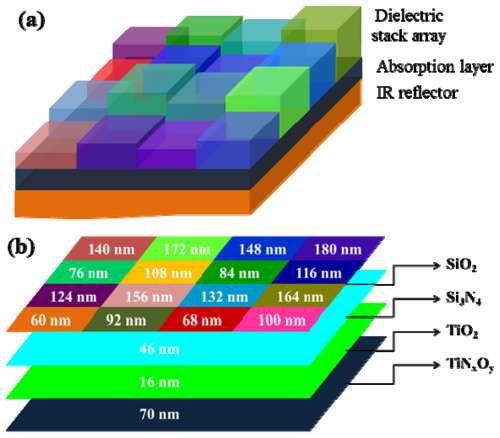Making colorful buildings that convert solar light into energy

By converting sunlight into usable energy, solar thermal devices could become an important part of a sustainable future. To that end, researchers have developed a new solar-light-absorbing surface that can have almost any design, pattern, and color – useful for turning building facades and roofs into energy-capturing exteriors without sacrificing aesthetics.
Since they also use similar materials as existing solar absorbers, this new kind of solar absorber could lead to wider use of solar thermal technology and more energy efficiency, said Shao-Wei Wang, Shanghai Institute of Technical Physics, China. Wang and his colleagues describe their design in Optics Express, a journal of The Optical Society (OSA). "A significant amount of energy might come from our building facades and roofs," he said.
One of the most common uses of solar thermal technology is to heat water, allowing for an enjoyable hot shower or a dip in a warm swimming pool. Hot water could also heat buildings during winter. Additionally, solar thermal technology can generate electricity. While solar panels convert sunlight directly into electricity, solar thermal devices use sunlight to first boil a liquid like water, producing gas or steam that drives power generators.
At the heart of this technology are layered surfaces called solar selective absorbers, which, as their name implies, are made from materials that absorb sunlight. To be efficient and hold onto heat, the emission of infrared light must be minimal. The problem with conventional absorbers is that the best ones are always black or dark blue. If you're hoping to incorporate the technology into a building, such a dark color doesn't always fit with the architecture and aesthetics. "A colorful world is much better than a monotonous dark one," Wang said.
Previous attempts at colorful solar absorbers have been limited. For example, the materials either couldn't absorb all wavelengths of sunlight or they emitted a lot of infrared. Each absorber also had to be the same color, making it expensive and difficult to design a façade with an image or a complex pattern.
The new absorber is covered with multiple layers of transparent dielectric materials, which can reflect light of a particular color. By changing the thickness of these layers, the researchers can tune the absorber to reflect light of almost any shade required. Some parts of the absorbing layer can be covered with a thicker transparent dielectric layer than other parts, allowing the researchers to create a single absorber with a rainbow of hues. And, it works almost as well as the best conventional ones.
In particular, the researchers made a square absorber 60 mm on each side. They covered the absorber with a mosaic of dielectric materials, forming a grid of 16 tiles. Each tile was of a different thickness – and thus a different color. Each tile, which could be made as small as one millimeter on each side, acts like a pixel on the absorber.
Using this methodology, an absorber with up to a thousand of these pixel-like color units – which would be virtually impossible with conventional absorbers – can be built and form almost any pattern you want, Wang said. For example, you could make a camouflage pattern, which would be useful for making solar thermal devices for the military.
While the technology isn't market-ready yet, he said that with enough industry investment, the methods could be commercialized in the near future.
More information: Feiliang Chen et al. Colorful solar selective absorber integrated with different colored units, Optics Express (2015). DOI: 10.1364/OE.24.000A92
Journal information: Optics Express
Provided by Optical Society of America



















